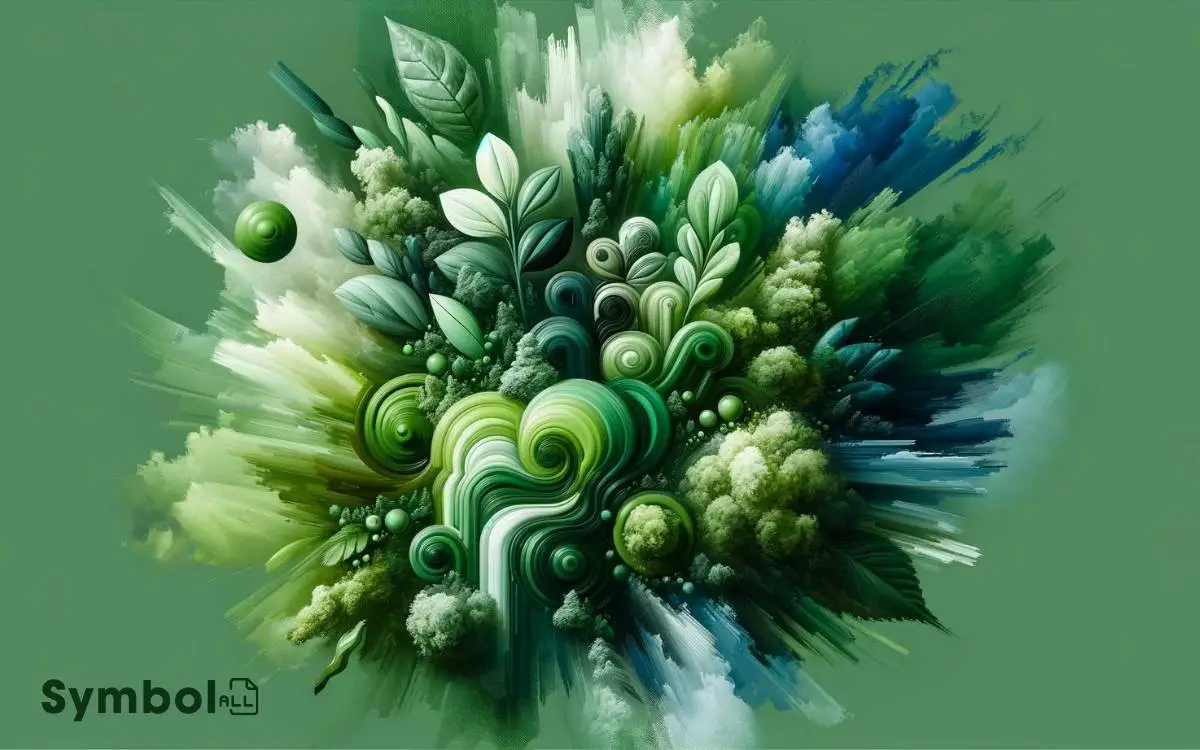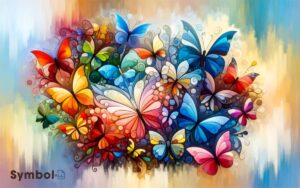What Color Symbolizes Mental Health? Green!
Green is the color you often associate with mental health due to its symbolism of growth, harmony, and renewal. It’s not just a preference but backed by history and research.
Ancient traditions understood green’s calming influence, integrating it into environments to promote well-being. Today, the green ribbon serves as a global symbol for mental health awareness, encouraging open conversations and reducing stigma.
Exposure to green spaces has been proven to lower stress levels and enhance mood. Behind this color’s tranquil facade are deeper benefits: soothing the mind, fostering resilience, and inspiring hope.
As you look beyond its aesthetic appeal, you’ll discover more about its transformative power in the context of mental health.

Key Takeaways
The Significance of Color
Colors profoundly influence our emotions and mental state, serving as a powerful tool in symbolizing and understanding mental health. Colors profoundly influence our emotions and mental state, serving as a powerful tool in symbolizing and understanding mental health. For instance, the color purple frequently represents qualities like resilience, hope, and transformation, which can resonate deeply with those navigating mental health challenges. Interestingly, the meaning of purple in cancer is similarly significant, symbolizing survival, awareness, and support for individuals affected by the disease, creating a parallel between physical and emotional healing.
You’ve likely felt calmer in a blue room or energized by a splash of yellow. These aren’t coincidences; they’re rooted in psychological research.
Blue, often associated with tranquility and stability, can soothe your mind, making it a color frequently linked to mental health awareness.
On the other hand, bright colors like yellow and orange, symbolizing happiness and energy, can uplift your spirits. However, the impact of color is deeply personal and can vary widely among individuals.
Understanding this can help you create environments that positively affect your mental well-being, using color as a silent yet potent ally in your mental health journey.
A Brief History of Green
Expanding on the understanding that colors like blue and yellow can greatly influence our mental state, it’s also vital to explore the role of green in this dynamic context. Historically, green has symbolized growth, harmony, and renewal.
Ancient civilizations believed in its soothing properties, integrating green spaces in their environments to promote wellbeing.
This affinity towards green isn’t coincidental but deeply rooted in our evolution. As humans, our eyes are sensitive to green, given its prevalence in nature, which likely offered a survival advantage by helping our ancestors find food and water.
Scientific studies have since confirmed that exposure to green can reduce stress, enhance mood, and improve cognitive function.
Understanding green’s historical significance helps us appreciate its continued relevance in promoting mental health today.
Green and Mental Health
You’ve likely seen the green ribbon, a universal symbol for mental health awareness that embodies hope and support for those affected.
Studies have shown that exposure to green spaces can substantially reduce stress levels, highlighting nature’s powerful role in enhancing mental well-being.
This connection between green and mental health isn’t only symbolic but deeply rooted in evidence, underscoring the color’s importance in fostering a supportive and healing environment.
Green Ribbon Significance
The green ribbon has become a universal symbol, representing awareness and support for mental health issues, reflecting a commitment to fostering open conversations and reducing stigma.
When you wear or display a green ribbon, you’re not just accessorizing; you’re signaling a safe space for dialogue about mental health challenges. This simple act can be profoundly empowering for those who struggle in silence, fearing judgment or misunderstanding.
Studies show that visible support systems, such as the green ribbon, greatly contribute to the destigmatization of mental health issues. They encourage individuals to seek help and remind the community of the importance of mental wellness.
By embracing the green ribbon, you’re part of a global movement towards compassion, understanding, and holistic health.
Natures Healing Influence
Building on the importance of the green ribbon in promoting mental health awareness, it’s crucial to explore how the color green itself, especially as it appears in nature, supports psychological well-being.
Research has consistently shown that spending time in green spaces, such as parks or gardens, can greatly reduce stress, anxiety, and symptoms of depression. This connection isn’t just about aesthetics; it’s deeply rooted in our psychology.
Green environments are known to enhance mood, improve attention and cognitive function, and even decrease blood pressure.
Symbolism Across Cultures
While exploring the symbolism of color in mental health, it’s important to recognize that meanings can vary greatly across different cultures.
- In some Asian cultures, white is often associated with mourning and loss, contrasting with Western interpretations of purity and peace.
- Red, frequently seen as a color of passion and energy in Western contexts, can signify good fortune and joy in many Eastern traditions.
- Blue, which might symbolize calmness and stability in the West, is sometimes seen as a color of mourning in parts of the Middle East.
- Green’s association with nature and growth is quite universal, although its specific implications for mental health can differ, reflecting cultural nuances.
Understanding these diverse perspectives enhances empathy and supports more inclusive approaches to mental health discussions.
The Psychology of Green
Exploring the psychology of green, it’s important to understand how this color can greatly influence your mental and emotional well-being, supported by various studies and cultural interpretations.
Green, often associated with nature, symbolizes growth, harmony, and renewal.
Its presence in your environment can soothe your mind, reducing anxiety and enhancing feelings of calmness. When you’re surrounded by green, whether it’s through plants in your space or green walls, you’re likely to experience a drop in stress levels.
This is because green has a calming effect on the nervous system, encouraging relaxation and helping to foster a more positive mood.
Additionally, green’s association with renewal can inspire feelings of hope and resilience, essential elements in maintaining mental health. Understanding green’s impact can be a step towards nurturing your mental well-being.
Green in Awareness Campaigns
In the domain of mental health awareness campaigns, green’s symbolic representation of growth and renewal is strategically utilized to foster an essential message of hope and healing.
This choice isn’t arbitrary; it’s deeply rooted in the color’s psychological impacts and cultural associations.
By adopting green, campaigns effectively communicate crucial messages about mental health:
- Green symbolizes a new beginning, mirroring the journey of recovery.
- It represents the ongoing process of growth, reflecting the nature of mental health healing.
- The color promotes a sense of calm and safety, essential for those struggling.
- It aids in reducing stigma, encouraging open conversations about mental health issues.
Your understanding of green’s role emphasizes the thoughtful approach behind these campaigns, aimed at nurturing an environment where mental health is openly discussed and supported.
The Importance of Visibility
Understanding the role of green in mental health campaigns leads us to appreciate why making these issues visible is so important.
When mental health struggles are brought into the open, it breaks down the stigmas that often keep individuals from seeking help. Visibility fosters a community of understanding and support, showing those affected that they’re not alone.
Research has shown that public awareness campaigns markedly improve societal attitudes towards mental illness.
This visibility encourages conversations, making mental health a topic we can all talk about openly. It’s a potent step towards normalization and provides a platform for education and empathy.
Green Ribbon: A Global Symbol
The green ribbon has emerged as a powerful global symbol, uniting individuals and communities in their support for mental health awareness.
This emblem represents more than just an advocacy for mental health; it embodies a commitment to breaking down the stigma and fostering a society that embraces mental wellness with open arms.
Consider the following aspects of the green ribbon’s significance:
- Universality: It transcends cultural and geographical boundaries.
- Visibility: It serves as a visible commitment to mental health advocacy.
- Solidarity: Wearing it signals solidarity with those affected by mental health issues.
- Education: It sparks conversations and promotes education about mental health.
Beyond Color: Ongoing Advocacy
Advocating for mental health goes beyond wearing a green ribbon; it’s about actively engaging in conversations and actions that support and uplift those affected. Understanding the multifaceted approach to advocacy helps you see its impact.
Here’s how it breaks down:
| Method | Purpose | Outcome |
|---|---|---|
| Education | Increase awareness | Reduced stigma |
| Policy Change | Improve access | Enhanced support systems |
| Community Support | Foster solidarity | Strengthened resilience |
| Research Funding | Advance knowledge | Better treatments |
| Personal Stories | Humanize struggles | Increased empathy |
Each column represents a critical aspect of ongoing advocacy. By participating in these approaches, you’re contributing to a more informed and compassionate society.
It’s a reminder that your actions, big or small, have the power to make a significant difference in the lives of those dealing with mental health challenges.
Conclusion
Isn’t it remarkable how a simple color like green can carry such profound meaning?
As we’ve explored, green symbolizes mental health, offering a beacon of hope and solidarity.
This hue, deeply rooted in history and psychology, transcends cultural barriers, fostering a universal dialogue on mental well-being.
The green ribbon, a symbol of awareness and advocacy, reminds us that while visibility is essential, our commitment to mental health must go beyond mere color.
Let’s continue to nurture this conversation, ensuring it grows and thrives.






